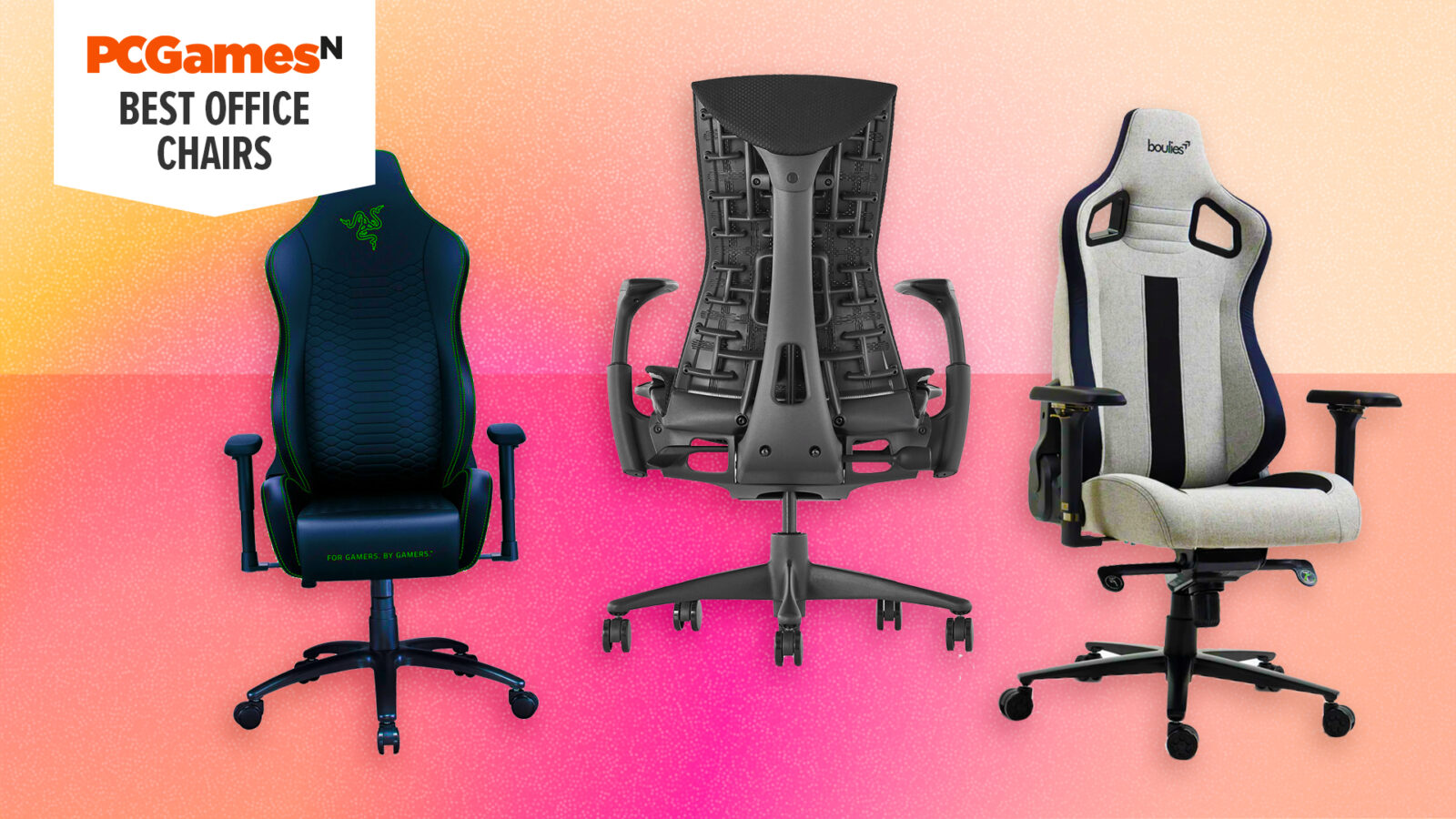What is the best office chair? A good office chair can save your posture and make life more comfortable when working or playing for long periods. If, like me, you sit down for a large part of the day and need the right chair to help your health, they’re an essential upgrade. We’ve been trying and testing the top options to help you find the right one.
Our top pick right now is the FlexiSpot C8/BS11 Pro, as it offers great comfort with good breathability and smart styling for a low price. Flexipost also gets our nod for the best budget office chair with its simple Flexispot OC3. Meanwhile, for peak adjustability, we recommend Sihoo Doro S300. For more options, check out the list below, and if you need more guidance on what to look for in an office chair, check out the how to choose section at the bottom of this guide, along with the FAQ that answers your office chair questions.
Why you can trust our advice ✔ At PCGamesN, our experts spend hours testing hardware and reviewing games and VPNs. We share honest, unbiased opinions to help you buy the best. Find out how we test.
Best office chairs:
How to choose the best office chair
The best office chair for you depends on your size and weight, how much you have to spend, how you usually sit, and what sort of design you’re looking for. While office chairs used to be black and bland, many chair brands such as Boulies, Branch, and Herman Miller now make gorgeous modern options in a spectrum of colors. If design is important, there’s a good chance you can find a chair in colorway that blends in with your office space.
Another aspect of the design is comfort and adjustability. Cheaper chairs generally offer less overall support and have fewer ways to tweak the chair’s height and angle, while premium offerings will allow you to tailor the lumbar support, change the tilt amount, and even shift the chair’s seat back and forward.
Also think about how you sit most while working. Is it on a laptop? On a desktop? A larger seat base means you can sit cross-legged, and a taller chair with a headrest can be comfortable if you plan to sit back in a reclined position to game.
Once you’ve chosen your chair, dedicate some time to adjust it to your proportions. Setting up most chairs should only take a few minutes initially – setting the seat height, lumbar level, and armrest position, for instance – but it can take a few weeks to fully get a sense of what’s right for you and your chair, so don’t be disheartened if you don’t get it right the first time.
Office chair FAQs
What’s the difference between office chairs and gaming chairs?
Broadly speaking, there isn’t really a meaningful difference these days, other than style. Gaming chairs tend to still have a car racing seat look with chunky build quality, but there are plenty of exceptions. Meanwhile, office chairs tend to have a lighter build, often using mesh seats and backs, and focus on ergonomics and adjustability, but again there are exceptions and plenty of cheap office chairs are very far from comfortable.
On balance, though, if you’re primarily looking for all-day-sitting comfort on a budget, a mid-range office chair will get you that for a lower price than a gaming chair. Options like the FlexiSpot C8/BS11 Pro and Sihoo Doro C300 offer fantastic comfort and adjustability for under $300 while many gaming chairs of the same price are built more sturdily but have less adjustment and support.
Does a good office chair make a difference?
Absolutely. You’re likely to spend a long time sitting down in your office chair each day, and it’s no exaggeration to say that an inferior product could reduce your quality of life and comfort. Over time, badly designed office chairs can genuinely be a leading cause of all sorts of aches and pains.
Is a hard chair better for your back?
Yes and no. If you go for a truly soft, unsupportive chair that you sink into, this will potentially do more harm to your back than a harder chair. However, good support doesn’t have to mean a chair is actually hard. Instead, a good office chair should cushion but gently support your legs and back in key areas. That’s one of the reasons quality mesh chairs are so good. Not only does the mesh provide breathability to reduce sweat but it can (if taught enough and properly shaped) provide an excellent balance of support and cushioning.
For the best support, look out for chairs that have a deep lumbar support curve, or adjustable lumbar support, along with a seat cushion that curves upwards in the middle and slopes off at the front. The latter helps distribute your weight evenly and stops pressure on the underside of your legs. The FlexiSpot C8/BS11 Pro and both Sihoo Doro chairs on this list offer these crucial features.
What makes an office chair ergonomic?
An ergonomic chair is one that is designed to support your body as much as possible. One that has been designed with no regard for ergonomics will likely be detrimental to your health. If you have back problems or any other health concerns, you should consult a medical professional about how best to tackle the issue, however, the following points give a useful overview of what ergonomic office chair design looks like:
Height adjustment
The absolute first consideration for an office chair is that is has height adjustment. Your legs should rest with your feet flat on the floor and your knees bent at a 90-degree angle. Most chairs will allow you to adjust the height of your seat to ensure that your legs and feet rest comfortably, but the range of heights that they offer varies quite a lot.
Lumbar support
Lumbar support is the next most important feature for an office chair. By curving towards your lower back, lumbar supports help to gently hold, well, support your lower back. This extra relief can seriously take the strain off your spine when sat for a long time. Look for chairs with a deep lumbar curve that’s ideally adjustable in both height and depth so you can tune the support to your spine.
Cushioning / mesh
Quality padding on a chair shouldn’t be overlooked as a crucial comfort consideration. Cheap office chairs have very thin padding that squashes down and feels hard after a very short time. For foam padding, you want deep padding that feels slightly firmer than you might is comfortable. This padding will hold up to long term sitting without squashing. Also make sure the seat padding curves away at the front edge so it doesn’t dig into the underside of your legs.
Mesh chairs are a great alternative to foam padding as they’re breathable but can also offer that same long terms soft support. Again, look for a curve seat and back mesh that it firmer/springier than you might think as this will offer the best long terms support – weak mesh will just give way.
Tilt and recline
Tilting and reclining a great options for occasionally sitting back and relaxing. Look out for chairs that offer a tilt function that also adjusts the angle of the seat, not just the back, and is properly balanced. These let you simply unlock the chair’s tilt mechanism and lean back for a comfortable recline.
4D armrests
Good armrests can be a great addition for some office chair users, though many users prefer to go without. Armrests can offer a little bit of support that just takes the strain off your arms and shoulders. However, they can also just get in the way, particulary if you like to tuck your chair in close to your desk. The best armrests offer a lot of adjustment so that you can tuck them out the way if not needed but be brought in to offer just the right height and positioning to support your arms. Also, look out for reports of armrests being particularly hard – a hard armrest is little better than no armrest at all.
There’s a lot more depth to the world of ergonomics, but this at least should give you a point of reference to consider when choosing a chair that’s good for your body.
Where next? If you want to reduce the time you spend sitting down, check out the best standing desks for gaming. Or, for more seating options, have a read of our best gaming chair guide.











Leave a Reply